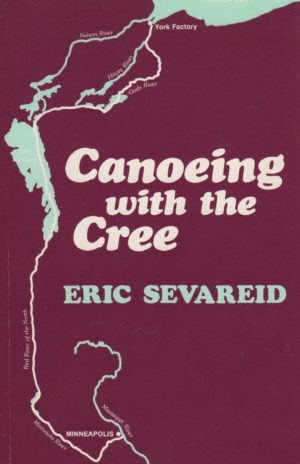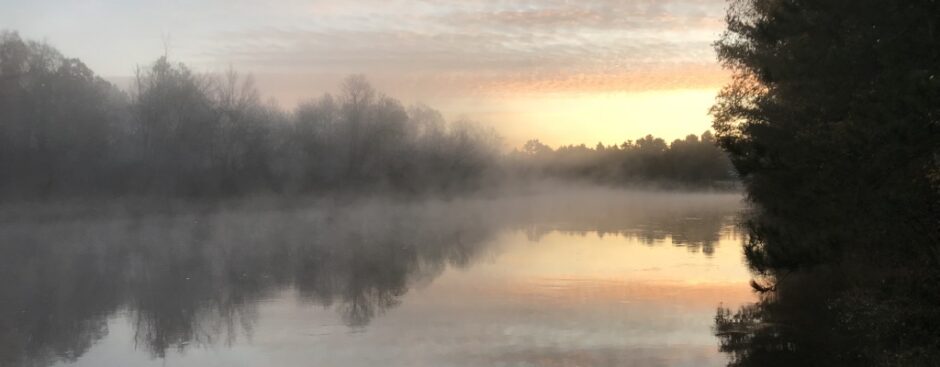

My friend, Kenny Hubert, finally got me intrigued enough in Sevareid’s meditation on youth, danger, and the far north for me to pick up a copy of Canoeing with the Cree last fall. Why was I inspired by my old friend to read an old book? Simply put, I was enthralled by Ken’s rendition of the trip that he and his brother-in-law Keith took replicating Sevareid’s epic northward paddle from Minnesota to Hudson Bay. I’d heard of Sevareid’s book, chronicling his journey from St. Paul to York Factory in a canvas and cedar strip canoe with a buddy (Sevareid was 17; his partner, Walter Port was 19), and had always wanted to read the narrative of that trip but never quite got around to it. When Ken related his version of his trip (which began in Keith’s hometown of Crookston and followed the Red Lake River south to its confluence with the Red River of the North-the river Sevareid and Port navigated to Winnipeg and beyond), it compelled me to locate a copy of Sevareid’s reportage. I found a used copy of the book but didn’t get around to reading Canoeing With the Cree until I was on vacation this winter. Here’s my take.
For anyone with wanderlust or a love of the out-of-doors or paddling, though it’s been said a million times, I’m certain, Canoeing with the Cree is a must read. Sure, as I’ll detail when reviewing the book’s anthesis, Canoeing with José, Sevareid’s journaling of a dangerous and arduous trek by water contains many pejorative references to Native American tribes, people, customs and the like. Modern commentators have criticized Sevareid-and rightly so-for his lack of cultural sensitivity when dealing with the scenes in the book involving his interactions with Native people; the very people who saved Sevareid and Port from injury, disaster, and death. But such objectionable references must be read in the context of Sevareid’s young age, his inexperience with indigenous people, and the times in which he lived. That said, the author does make it clear that he and Port would have never completed their journey, and likely would have perished, but for the kindness of strangers-white and non-white-met along the way. The criticisms of the book based upon today’s cultural sensitivity and knowledge of the travesties committed, both in the US and Canada, against the Sioux, Ojibwe, and Cree are spot on. But there remains, beneath that tarnish, a gem of a road story of two young men challenging themselves and nature.
As I relate below, when compared with a more recent reportage of a similar journey, Canoeing with the Cree loses a bit of its original luster. Sevareid’s prose is fairly simple and his themes and commentary seem dated. Still, this is an epic “buddy tale” that shouldn’t be missed just because some of its content isn’t politically correct.
4 stars out of 5.
Canoeing with José.
I bought Sevareid’s book at my favorite Bayfield, Wisconsin bookstore, Honest Dog Books (http://honestdogbooks.com/). Julie, one of the thoughtful owners, was the one who suggested, since I was going to read Canoeing with the Cree I should also pick up Canoeing with José. I followed her advice and I’m glad I did!
Jon Lurie, a Jewish guy with absolutely no wilderness canoeing credentials, befriends (maybe that’s too strong a term; theirs is a thorny and stormy relationship) José. The connection begins when Lurie is asked, because José is working as an intern on a a Native American newspaper, The Circle, to mentor the teenager whose ethnicity includes Puerto Rican and Lakota heritage. Things get off to a rocky start due to José’s reluctance to open up to Lurie about the trauma-both historic and personal-that has defined his young life. But, when Lurie suggests the two of them retrace Sevareid’s and Port’s journey as a means of spiritual cleansing and rejuvenation, José agrees.
It must be pointed out that the modern-day paddle up the Red River into Canada and beyond has several critical distinctions from the voyage Port and Sevareid embarked upon.
Lurie and José began their paddle on the Red River, choosing to begin their trip not in the Twin Cities as the original pair did but at Breckenridge, Minnesota, where the Otter Tail and Bois de Sioux Rivers converge to form the Red. This is significant, not in the literary sense but in the historic sense, because the first five chapters of Canoeing with the Cree detail Sevareid’s and Port’s miserable paddle up the Minnesota River and its connectors before arriving at Lurie’s point of departure. The original trip, as detailed in Sevareid’s book, took a full three weeks of work to complete; an additional three weeks of hardship that the modern-day team of canoeists avoided.
In addition, Sevareid and Port paddled, with minor exception, nearly the entire length of Lake Winnipeg, a distance of some 260 miles from north to south in a straight line. Of course, paddling a huge body of water in an eighteen-foot cedar and canvas canoe isn’t practicable; careful canoeists like Sevareid and Port meander from protected island to the shoreline, working their way gingerly northward, avoiding open water whenever possible. By way of contrast, Lurie and José transported their modern-day canoe by rental car to the north end of the lake, avoiding much of the consternation and danger that confronted and confounded the original journeymen.
Once the 21st century canoeists reached Norway House, they entered a series of rivers and lakes flowing north to Hudson Bay by way of the Hayes River system. According to both accounts, that’s the traditional route of the Cree and white trappers and adventurers seeking to paddle from Lake Winnipeg to York Factory. In 1930, when the boys made their trek, the Hayes was in the midst of drought. This required Sevareid and Port to change plans and head north by way of Gods River, a route rarely, if ever used, to reach Hudson Bay.
Canoeing with José is far less a story of wilderness survival and heroic exploits than Sevareid’s work.There is an element of that, to be sure, in Lurie’s account, especially given the relative lack of skills both he and José possess in regards to such an endeavor. But the guts of the newer tale is an introspection by Lurie and José juxtaposed against the history of white privilege and the shameful treatment of Native Americans and Indigenous Canadians. In many ways, this deep dive into history, a history that José feels in the every day stares of white folks he encounters in his hardscrabble life in the Twin Cities but has no real understanding of beyond intuition, is what makes Lurie’s work more compelling, more engaging, and ultimately, more compassionate than Sevareid’s. To be fair, Lurie was 34 and living in our contemporary world when he penned his book; Sevareid made his journey when he was 17 and published his story in 1935, when he was only 22 years old, writing at a time when there was little understanding amongst the majority white populations of the US and Canada of the cultural damage governmental policies had imposed upon the Indians of both nations. That having been said, Canoeing with José is the better written of the two in terms of overall style, language, story, and present day relevance.
One cannot discount the bravery, tenacity, and endurance exhibited by either pair but the later chronology is far more complex and detailed in its examination of what such journeys mean in the context of history and where we are today in terms of understanding that history. 5 stars out of 5. I’d suggest that book clubs and/or readers read both books, in sequence of publication.
Peace.
Mark


